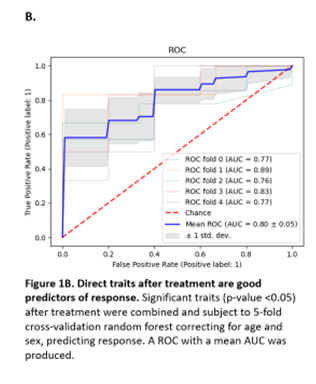P803 Plasma N-glycan biomarkers predict patient Response to Vedolizumab treatment for Crohn’s Disease
Elgood Hunt, G.(1)*;Adams, A.(2);Senard, T.(1);Gardner, R.(1);Jonge, W.(3);Li Yim, A.(3);Noble, A.(2);Satsangi, J.(2);Joustra, V.(3);D'Haens, G.(3);Spencer, D.(1);
(1)Ludger, Development, Oxford, United Kingdom;(2)Oxford University, Experimental Medicine Division, Oxford, United Kingdom;(3)University Medical Centre, Inflammatory Bowel Disease Centre, Amsterdam, The Netherlands;
Background
Vedolizumab (VDZ) is a monoclonal antibody directed against α4β7 integrin used to treat Crohn’s disease, which has proven to be efficacious in phase 3 clinical trials¹ and in real-world studies². However, there is a need for reliable biomarkers to predict whether an individual patient will respond to VDZ treatment. Glycosylation changes have been associated with CD, but have never been studied as potential predictors of remission to biological therapy³. A comparison of plasma N-glycan profiles between responders and non-responders to VDZ was used to detect potential biomarkers to response.
Methods
Plasma samples before (t1) and after (t2) initiation of vedolizumab treatment (mean follow up time at t2 215 ± 61 days) were taken from 58 patients with Crohn’s disease. They were analysed by high-performance liquid chromatography with mass spectrometry. Response to VDZ was assessed by a combination of clinical and endoscopic outcomes and was observed in 34 of 58 patients. 89 direct glycan traits met the criteria for quantification and were extracted from the data via LacyTools. Consequently, 21 derived glycan traits were calculated by combining direct traits with shared structural similarities. Correcting for age and sex, the direct and derived traits were tested across responses using logistic regression and cross-validation to determine which traits at t1 are predictive of response (p-value < 0.05) and traits at t2 are markers of response (p-value < 0.05).
Results
Two glycans, MAN6 (0.65 AUC) and FA2G2S2 (0.7 AUC) were higher in responders prior to treatment and moderate predictors of response, with no improvement in a combined model (figure 1A). Congruent to previous studies, galactosylation levels increased in responders after treatment. Overall, 17 direct traits and 4 derived traits were markers of response after treatment and collectively proved to be good predictors of response (0.80 AUC) (figure 1B).


Conclusion
This study has demonstrated multiple N-glycans are indicators of future response to VDZ treatment, with the potential to guide clinicians in determining the most appropriate form of treatment for individuals. These data require to be validated in the future; and to be assessed alongside other emerging biomarkers.
References
1 Sands BE, et al .2014 Sep;147(3):618-627.e3
2 Bressler B,et al.2021 Mar 30;15(10):1694–706.
3 Šimurina M, et al. 2018 Apr;154(5):1320-1333.e10


